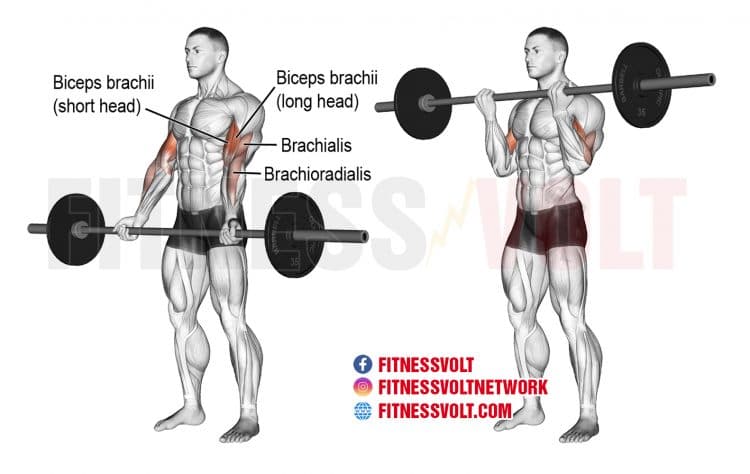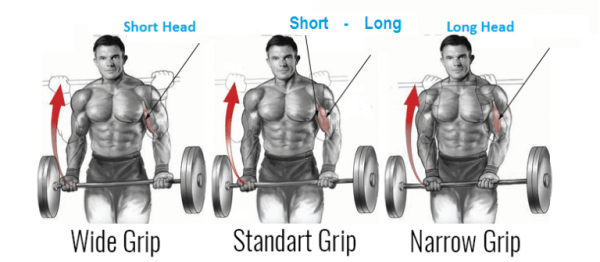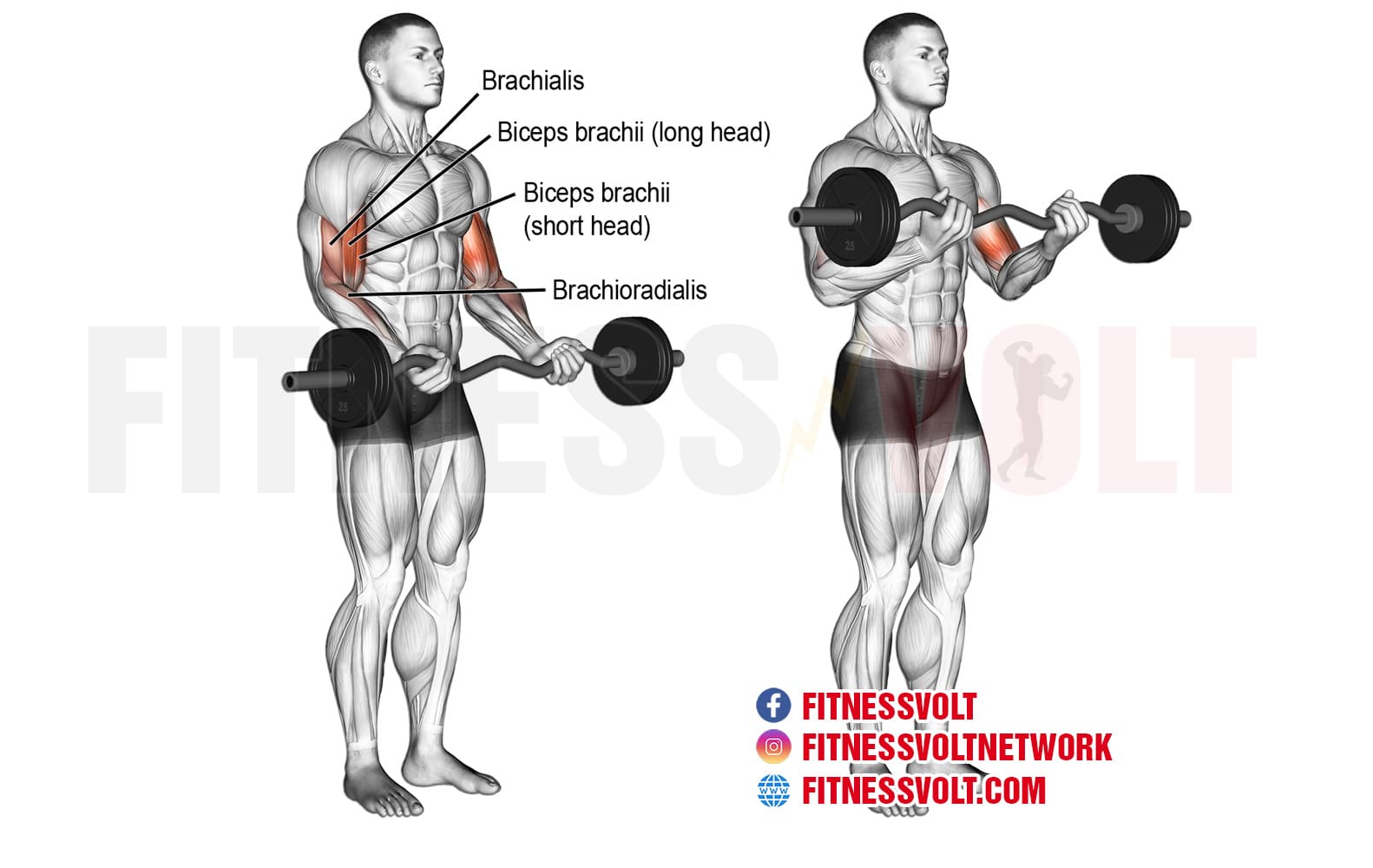Have you ever wondered what muscles are being targeted when you perform barbell curls? Well, you’ve come to the right place! Let’s dive into the world of barbell curls and discover which muscles are getting a workout.
When it comes to barbell curls, the main muscles being targeted are the biceps. These muscles are located at the front of your upper arm and are responsible for flexing and pulling your forearm towards your shoulder. However, it’s important to note that the biceps have two heads – the long head and the short head.
The barbell curl primarily targets the long head of the biceps, which is the outer head that gives your arms that desirable peak. This doesn’t mean that the short head is ignored though. It also gets activated during barbell curls, but to a lesser extent compared to the long head.
In our upcoming article, we’ll explore the mechanics of barbell curls in more detail and discuss why targeting both the long head and short head of the biceps is important for a well-rounded arm workout. So, if you’re looking to achieve those strong and defined biceps, stay tuned and we’ll uncover all the secrets behind barbell curls!
Barbell curls are one of the most popular exercises for targeting the biceps, but do you know which specific muscles within the biceps barbell curls work? In this article, we will delve into the specific muscles targeted by barbell curls and explore their roles in the exercise. Whether you’re a beginner or a seasoned lifter, understanding the muscle activation and mechanics behind barbell curls can help you optimize your bicep training and achieve the best results.

Muscles Targeted by Barbell Curls
Biceps Brachii
The biceps brachii, commonly known as the biceps, is the primary muscle targeted by barbell curls. It is a two-headed muscle consisting of the long head and the short head. The long head originates from the supraglenoid tubercle of the scapula, while the short head originates from the coracoid process. Both heads of the biceps merge at the elbow and insert into the radius, a bone in the forearm.
Brachialis
The brachialis is another muscle targeted by barbell curls, although to a lesser extent compared to the biceps brachii. It lies underneath the biceps and acts as a synergist in elbow flexion, assisting the biceps in the movement. The brachialis originates from the anterior surface of the humerus and inserts into the coronoid process of the ulna.
Brachioradialis
The brachioradialis is a muscle located on the forearm that is also involved in barbell curls. It acts as a supporting muscle, providing stability and assisting in elbow flexion. The brachioradialis originates from the lateral supracondylar crest of the humerus and inserts into the styloid process of the radius.
Role of Biceps Brachii in Barbell Curls
Primary Muscle Activated
During barbell curls, the biceps brachii is the primary muscle activated. As you lift the barbell, the biceps contract to flex the elbow joint, bringing the forearm towards the upper arm. This movement is known as elbow flexion. The biceps brachii plays a crucial role in this movement, generating the majority of the force required to lift the weight.
Contraction Type
The biceps brachii undergoes a concentric contraction during the lifting phase of barbell curls. This means that the muscle shortens while generating force to move the forearm. The biceps then undergo an eccentric contraction during the lowering phase, where the muscle lengthens under tension.
Muscle Fiber Recruitment
Barbell curls primarily recruit the fast-twitch muscle fibers of the biceps brachii. These muscle fibers are responsible for generating high levels of force and are more conducive to hypertrophy, or muscle growth. However, it is important to note that barbell curls can target both the long and short heads of the biceps, promoting overall bicep development.

Role of Brachialis in Barbell Curls
Secondary Muscle Activated
While the main focus of barbell curls is the biceps brachii, the brachialis also plays a significant role in the exercise. As a synergist, the brachialis assists the biceps in elbow flexion. By working alongside the biceps, the brachialis helps to increase overall arm strength and size.
Importance for Arm Development
Targeting the brachialis is crucial for achieving well-rounded arm development. Its position beneath the biceps allows it to push the biceps outward, creating the appearance of larger and fuller arms. By incorporating exercises like barbell curls that activate the brachialis, you can enhance your arm aesthetics and improve overall arm strength.
Role of Brachioradialis in Barbell Curls
Supporting Muscle Activated
The brachioradialis is not directly involved in elbow flexion during barbell curls, but it plays a supporting role in stabilizing the forearm. It ensures proper alignment of the forearm with the upper arm, allowing for a more controlled movement. The activation of the brachioradialis can help prevent unnecessary strain or injury during barbell curls.
Forearm Involvement
Barbell curls also engage the muscles in the forearm, including the brachioradialis. As you grip the barbell and maintain your hand position, the brachioradialis contracts to stabilize the wrist and forearm. This involvement of the forearm muscles adds to the overall strength and stability of the exercise.

Tips for Proper Barbell Curl Technique
To get the most out of your barbell curls and effectively target the muscles mentioned above, it is essential to perform the exercise with proper technique. Here are some tips to keep in mind:
Grip and Hand Position
Hold the barbell with an underhand grip, palms facing upward. Your hands should be shoulder-width apart or slightly wider. This grip allows for optimal engagement and activation of the biceps brachii.
Elbow Position
Keep your elbows close to your sides throughout the movement. Avoid allowing them to flare out, as this can shift the emphasis away from the biceps and onto the shoulders. Maintaining proper elbow positioning helps to isolate the biceps and maintain tension on the muscles throughout the exercise.
Range of Motion
When performing barbell curls, aim for a full range of motion. Lower the barbell until your arms are fully extended, allowing a stretch in the biceps and brachialis. Then, squeeze your biceps as you curl the barbell up toward your chest, aiming to bring it as close to your shoulders as possible. Focusing on a complete range of motion ensures maximal muscle activation and promotes better muscle development.
Variations of Barbell Curls to Target Different Muscles
While standard barbell curls effectively target the biceps brachii, incorporating different variations can help diversify your bicep training and target different muscles within the arms. Here are a few variations to consider:
Close-Grip Barbell Curls
Close-grip barbell curls involve holding the barbell with a narrower grip, approximately six to eight inches apart. This variation places more emphasis on the inner portion of the biceps, targeting the short head. By keeping your grip closer, you increase the involvement of the brachialis as well.
Wide-Grip Barbell Curls
In contrast to close-grip barbell curls, wide-grip barbell curls involve holding the barbell with a wider grip, typically wider than shoulder-width apart. This variation primarily targets the outer portion of the biceps, emphasizing the long head. Incorporating wide-grip barbell curls into your routine can lead to better bicep development and create a more rounded appearance.
Preacher Curls
Preacher curls are performed on a preacher bench, which provides support for the upper arms and isolates the biceps. This variation allows for strict form and reduces the involvement of other muscles. Preacher curls can be done with a barbell or dumbbells, and they effectively target both the long and short heads of the biceps.

Benefits of Barbell Curls
Barbell curls offer a multitude of benefits beyond just bicep development. Here are a few reasons why you should incorporate barbell curls into your workout routine:
Strength and Muscle Size
Barbell curls are an excellent exercise for building strength and muscle size in the arms. By consistently challenging the biceps and other muscles involved, you stimulate muscle growth and development. Over time, this can lead to increased upper body strength and improved overall muscularity.
Arm Aesthetics
The biceps are one of the most prominent muscles in the arms, and well-developed biceps can significantly enhance your arm aesthetics. Barbell curls, when performed correctly and with proper intensity, can help sculpt and define the shape of your biceps, giving your arms a more appealing appearance.
Functional Strength
While barbell curls primarily target the biceps and other arm muscles, they also engage other muscles in the body, such as the forearm muscles, core, and even the back muscles to some extent. This activation of multiple muscle groups improves overall functional strength, enabling you to perform daily activities more efficiently and with less risk of injury.
Common Mistakes and Potential Risks
To ensure a safe and effective barbell curl workout, it is important to be aware of common mistakes and potential risks associated with the exercise. By avoiding these mistakes, you can minimize the risk of injury and maximize your results. Here are a few common mistakes to watch out for:
Using Momentum
One of the most common mistakes made during barbell curls is using momentum to lift the weight. Swinging the barbell or allowing the elbows to rise can take the focus away from the biceps and reduce the effectiveness of the exercise. To maximize the benefits of the exercise, maintain strict form and use controlled movements throughout the entire range of motion.
Excessive Weight
Lifting too much weight can compromise your form and increase the risk of injury. It is important to choose a weight that allows you to maintain proper technique throughout the exercise. By using a weight that challenges your muscles without sacrificing form, you can effectively target the intended muscles and minimize the risk of strain or injury.
Improper Form
Performing barbell curls with improper form can not only decrease the effectiveness of the exercise but also lead to injuries. Some common form mistakes include rounded shoulders, leaning back, or swinging the body. To maintain proper form, focus on keeping your back straight, shoulders back and down, and elbows close to your sides throughout the entire movement.

Alternative Exercises to Supplement Barbell Curls
While barbell curls are an effective exercise for targeting the biceps, incorporating alternative exercises into your workout routine can help provide variety and ensure overall arm development. Here are a few alternative exercises to consider:
Dumbbell Curls
Dumbbell curls are similar to barbell curls but involve using dumbbells instead of a barbell. This exercise allows for a greater range of motion and enables you to work each arm independently, promoting balanced muscle development. Dumbbell curls can be performed in various ways, including alternating curls, hammer curls, or concentration curls.
Hammer Curls
Hammer curls target not only the biceps but also the brachialis and brachioradialis. This exercise involves holding dumbbells with a neutral grip (palms facing each other) and curling the weights toward the shoulders. Hammer curls contribute to overall arm development and can help create a more three-dimensional appearance.
Chin-Ups
Chin-ups, although primarily a back exercise, also engage the biceps as secondary muscles. By pulling yourself up using an underhand grip on a pull-up bar, you involve the biceps in moving your bodyweight. Chin-ups provide an excellent compound movement to complement barbell curls and promote overall upper body strength and development.
Conclusion
Barbell curls are a staple exercise for targeting the biceps and developing arm strength and aesthetics. By understanding the specific muscles targeted by barbell curls and their roles in the exercise, you can optimize your bicep training and achieve better results.
Incorporating proper technique, variations, and alternative exercises into your workout routine will help you maximize muscle activation and minimize the risk of injury. Whether your goal is to build strength, increase muscle size, or enhance arm aesthetics, barbell curls are an essential exercise to include in your training arsenal. So grab a barbell, focus on your form, and get ready to feel the burn in your biceps!




